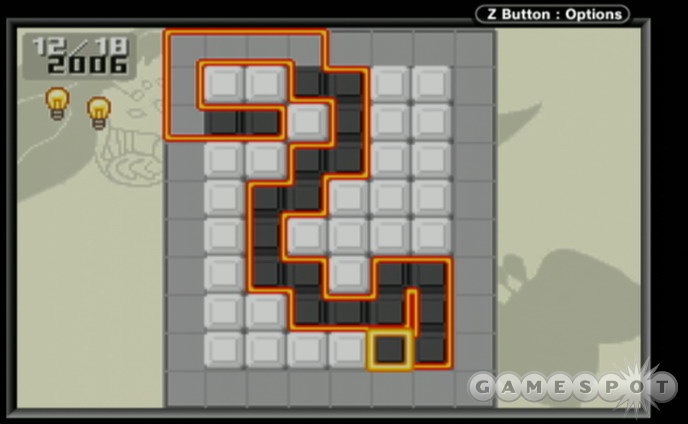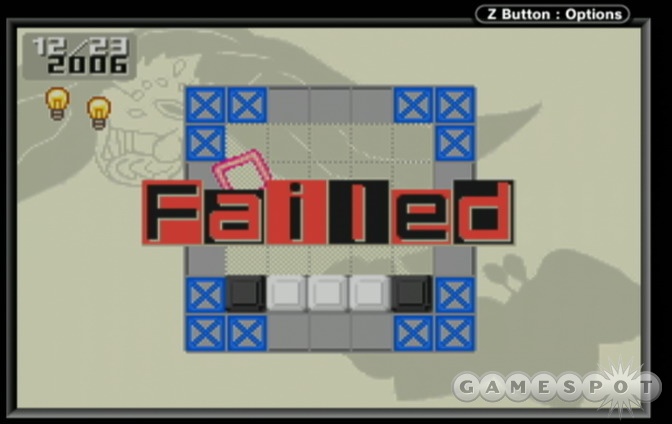Originally released in the middle of 2005, Polarium was one of the first original puzzle games developed for the Nintendo DS. The tile-flipping gameplay was a good fit for the DS's touch-screen controls, so a Game Boy Advance translation of the concept doesn't seem like an obvious choice. Then again, the simple elegance of Polarium's design carries over to Nintendo's older portable platform quite well. The result is Polarium Advance, an understated puzzle game without much personality but with plenty of brainteasers to keep you busy for a while.

The object of any puzzle in Polarium Advance is similar to the board game Othello: to turn all rows of tiles onscreen either white or black in a single, linear stroke that causes the selected tiles to change to the opposite color. The typical puzzle is a gridlike field with some black tiles and some white tiles. Selecting a set of tiles causes them to flip over, and if a straight row of that color is then formed, the line disappears. You're trying to clear the entire playing field in one such move and doing so will often involve inching around the edges of the field, trying to avoid dead ends while looking for ways to turn just one or two pesky tiles over without breaking a row. If you fail to clear the field, you'll see which tiles are remaining and may then quickly try again, with your last-attempted path through the puzzle preserved so that you may retrace your steps and try something a little different. In this fashion, it becomes possible to finish just about any puzzle using pure trial and error. However, it's natural to try and figure these out intelligently, if only because it's faster than seeing what happens by cutting random swaths through the playing field.
The gameplay in Polarium Advance is made somewhat more complex due to a few types of special tiles that appear in certain puzzles, such as ones that prevent you from passing through. So in spite of the simplicity of the design--the game is a lot easier to figure out than it is to describe--some of the puzzles are seriously challenging. For one, it can be tricky to decide whether you should turn all the white tiles black or all the black tiles white in a given row. Puzzles in Polarium Advance are ranked for their difficulty and range from very easy on up to very hard. The more you play this game, the more you'll get in the proper mind-set for solving some of the tougher challenges.
Polarium Advance features several different modes of play that are different from the Nintendo DS version. The main puzzle mode is called Daily Polarium, and the premise here is that you're supposed to solve one puzzle a day for an entire year. There's no built-in restriction preventing you from skipping forward, and solving just one puzzle a day might not give you your fill. However, once the difficulty of these ramps up, cracking just the one tough puzzle a day might be enough to keep you coming back. You may revisit the puzzles you solve in this mode and attempt to beat them again in a specified number of moves or using predetermined start points and end points, which creates more lasting value around puzzles you might otherwise be able to tear through in droves.
There's also a time-attack mode, in which you can attempt to tackle either 10 "easy" puzzles or five "hard" puzzles in a row, while the clock is ticking. Failure to complete a puzzle in these sequences doesn't end your game, but it does impose a time penalty that hurts your score. Polarium Advance normally isn't a tense game, but the time-attack mode really forces you to think on your feet. And by randomizing which puzzles you get, it makes for challenging gameplay sessions that are suitable for when you only have a few minutes to play.

A training mode is available to help you learn the ropes of all this, and you can also create and save your own puzzles, too, thanks to an easy-to-use puzzle editor. It's possible to share these created puzzles with other Polarium Advance players due to a password system, which is a nice feature. Passwords from the Nintendo DS version of the game are also compatible.
Polarium Advance doesn't look or sound like much. You can choose from a few alternatives to the stock black-and-white tiles, and the music that plays in the background is fitting but easy to tune out. So this really is a puzzle game in the purest sense. That it's able to get by on the strength of its gameplay, without using any fancy bells and whistles to try to impress you, goes to show that Polarium Advance is worth considering if you like thinking while playing your games.